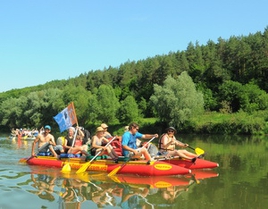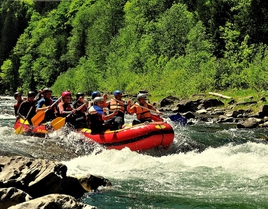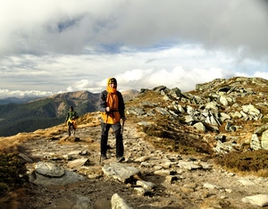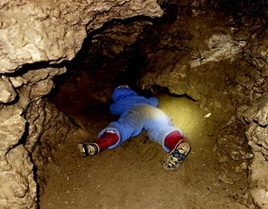Gear for climbing for high peaks
"High peaks" means high above 3500-4000 m . That mean that climbing may occur in areas covered with snow, at the temperature below zero, at windy weather and snowfall.
Hike starts in a gentle weather conditions that meet the summer or autumn Carpathians because of acclimatization and gradual increase in height.
1) Approach to Mount
Approach requires clothes and gear like for trekking. But final list must contain warm clothes for climbing.
Nuances:
- sleeping bag must have a comfort mode at least -5 degrees (warmer for girls).
- backpack is heavy because of all our climbing gear.
- at height above 3000 m will be felt effect of altitude.
2) Climbing
It's totally cold at height above 3000 m . At height above 4000 m (while climbing) can be -10 below zero, strong wind, snow, bright sun, fog.
During climbing there will be areas where we will stop to hang ropes, so you will have plenty of time to feel yourself cold. That means that you should be warm dressed. At the same time clothes must be lasting (to not to be damaged during a disruption or working with rope) and comfortable for usage ropes system.
For moving in good weather one must have a set of light clothing (thermal underwear, light sweater and windbreaker), and in bad weather or at halt (at camp) one should put on one more pair of pants, warm sweater and jacket.
| Boots |
An extremely important item of equipment. You need to have special shoes for winter trekking. Features: high, warm, thick sides, water-resistant coating, durable sole.
|
 |
| Gaiters |
Gaiters prevent boots from snow penetration, tightly seizing footwear around perimeter. |
 |
| Socks | You may have several pairs of some kinds and put them in the following order: thin plain (pleasant for body), thick wool (warm), thin synthetic (tightly fix a thick sock). |  |
| Thermo and windproof trousers |
It is desirable to have thermounderware or just thin underpants. Windproof pants protecting from the wind and repelling snow are put on top of them. It is comfortable to use self-removing trousers, which can be removed without removing shoes. |
 |
| Thermounderware |
Light golf or sweater, preferably with a membrane (or wool), pleasant for body. Cotton should be avoided as it dries for long. Membrane (polartec) and wool fabric keep warm well even being wet. |
 |
| Light sweater | It is convenient to have a sweater of thin fleece or equivalent. |  |
| Warm sweater | A thick wool or fleece sweater for severe frost or rest. |  |
| Windbreaker/raincoat | Light coat for moving during the day. Windproof and snow repellent. |  |
| Hat and mask |
Any hat At strong wind and frost a mask will protect the face from frostburn. |
 |
| Gloves |
Warm. The outer fabric is required to prevent from sticking snow. Preferably with a protective cuff from snow penetration. “Fingers together” are possible. Knitted or wool products are not suitable.
|
 |
| Warm coat | Warm coat shall be needed at halt and at a very bad weather. |  |
Notes:
- boots - must be compatible with your crampons;
- pants - combinations can vary depending on the available items in the inventory. Ski pants are good but you may feel cold in lower part of your leg (where ski boots should be). Also warm pants must have the opportunity for effective ventilation because the climb can be quite hot. If you take 3 pairs then again consider the possibility of ventilation. If you plan to wear extra pants while climbing - it must be haulers pants (you know how quickly wear).
- warm clothes - сlimb to the top starts at night, so it will be cold. So from the outset you can put on all the warm clothes at yourself and little undress during the first hour during warming. After reaching the glacier, after 2-3 hours you will need to redress yourself, because wind and cold will become stronger, and dress yourself will be more difficult because of the height and steep climb. While your return, you will be free to undress. Down jackets usually have thin and soft outward material, so not to damage it by ropes and relief you can wear a raincoat or windbreaker on it. Well, if the jacket shall allow you to work comfortably with the system and ropes (have to dress in the system).
Personal belongings
It is necessary to take only the necessary things according to a thought-out list.
| Winter sleeping bag |
The temperature of comfortable mode is minus 15 degrees. The weight is about 3 kgs. It must be well isolated from water. You can take them at our rent. |
 |
| Pad |
Polyurethane foam or inflatable mat. You can take them at our rent. |
 |
| Food set | Plate, spoon, cup (mug). A set should be lightweight and durable (plastic is subject to breakage). |
|
| Torch | It is best to have a headlamp with LED flashlight of Petzl Tikka XP type. |  |
| Thermos | Non-glass thermos with volume of 1 liter. |  |
| First-aid kit | Specific medications that you frequently use. |  |
| Seat* | For comfortable sitting on the different surfaces. |  |
| Means of hygiene | Toothbrush, toothpaste, soap, towel and more. |  |
| Documents | Passport. Waterproof. You sould always keep it to yourself. |  |
| Sunglasses* | Any. |  |
| Photocamera* | Any. | |
| Knife* | Not big in sheath or clasp knife. Keep out of reach of police. |  |
| Lighter* | Any. |  |
* -optional items
Personal mountain gear for climbing
| Carabiner – 3 pcs. |
At least one carabiner must have threaded sleeve.
|
 |
| Crampons | Must be compatible with your boots. |  |
| Prusyk | The diameter of 6-8 mm |  |
| Piolet with lanyard |
To be able to: fix a carabiner or spout top of the ice ax or strap must be reliable enough to use for insurance |
 |
| Lanyard – 2 pcs. | Loop slings or bound with rope 10mm. |  |
| Insurance system (bottom) |  |
|
| Helmet | Required only in one place in the interval 300 m |  |
Private mountain climbing gear can be rented at us. But some elements may be old-fashioned.
Approach requires clothes and gear like for trekking. But final list must contain warm clothes for climbing.
Nuances:
-sleeping bag must have a comfort mode at least -5 degrees (warmer for girls).
-backpack is heavy because of all our climbing gear.
- at height above 3000 m. will be felt effect of altitude





